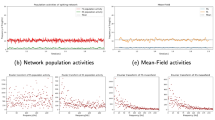Abstract
A functional expansion was used to model the relationship between a Gaussian white noise stimulus current and the resulting action potential output in the single sensory neuron of the cockroach femoral tactile spine. A new precise procedure was used to measure the kernels of the functional expansion. Very similar kernel estimates were obtained from separate sections of the data produced by the same neuron with the same input noise power level, although some small time-varying effects were detectable in moving through the data. Similar kernel estimates were measured using different input noise power levels for a given cell, or when comparing different cells under similar stimulus conditions. The kernels were used to identify a model for sensory encoding in the neuron, comprising a cascade of dynamic linear, static nonlinear, and dynamic linear elements. Only a single slice of the estimated experimental second-order kernel was used in identifying the cascade model. However, the complete second-order kernel of the cascade model closely resembled the estimated experimental kernel. Moreover, the model could closely predict the experimental action potential train obtained with novel white noise inputs.
Similar content being viewed by others
References
French AS (1980) Sensory transduction in an insect mechanoreceptor: linear and nonlinear properties. Biol Cybern 38:115–123
French AS (1984) Action potential adaptation in the femoral tactile spine of the cockroach, Periplaneta americana. J Comp Physiol A 155:803–812
French AS, Wong RKS (1977) Nonlinear analysis of sensory transduction in an insect mechanoreceptor. Biol Cybern 26:231–240
Hodgkin AL, Huxley AF (1952) A quantitative description of membrane current and its application to conduction and excitation in nerve. J Physiol 117:500–544
Hunter IW, Kearney RE (1983) Two-sided linear filter identification. Med Biol Eng Comput 21:203–209
Hunter IW, Korenberg MJ (1986) The identification of nonlinear biological systems: Wiener and Hammerstein cascade models. Biol Cybern 55:135–144
Korenberg MJ (1973a) Identification of biological cascades of linear and static nonlinear systems. Proc Midwest Symp Circuit Theory 18.2:1–9
Korenberg MJ (1973b) Cross-correlation analysis of neural cascades. Proc Ann Rocky Mountain Bioeng Symp 1:47–52
Korenberg MJ (1985) Identifying noisy cascades of linear and static nonlinear systems. IFAC Symp Ident Sys Param Est 1:421–426
Korenberg MJ (1987) Functional expansions, parallel cascades and nonlinear difference equations. In: Marmarelis VZ (ed) Advanced methods of physiological system modelling. USC Biomedical Simulations Resource, vol 1. Los Angeles, pp 221–240
Korenberg MJ (1988) Identifying nonlinear difference equation and functional expansion representations: the fast orthogonal algorithm. Ann Biomed Eng (in press)
Korenberg MJ, Hunter IW (1986) The identification of nonlinear biological systems: LNL cascade models. Biol Cybern 55:125–134
Korenberg MJ, Bruder SB, McIlroy PJ (1988) Exact orthogonal kernel estimation from finite data records: extending Wiener's identification of nonlinear systems. Ann Biomed Eng (in press)
Lee YW, Schetzen M (1965) Measurement of the Wiener kernels of a nonlinear system by cross-correlation. Int J Control 2:237–254
Marmarelis PZ, Marmarelis VZ (1978) Analysis of physiological systems. The white noise approach. Plenum Press, New York
Marmarelis PZ, Naka K-I (1972) White noise analysis of a neuron chain: an application of the Wiener theory. Science 175:1276–1278
Palm G, Poggio T (1978) Stochastic identification methods for nonlinear systems: an extension of the Wiener theory. SIAM J Appl Math 34:524–534
Sakuranaga M, Ando Y-I, Naka K-I (1987) Dynamics of ganglion cell response in the catfish and dog retinas. I. Gen Physiol 90:229–259
Sakuranaga M, Sato S, Hida E, Naka K-I (1986) Nonlinear analysis: mathematical theory and biological applications. CRC Crit Rev Biomed Eng 14:127–184
Wiener N (1958) Nonlinear problems in random theory. Wiley, New York
Zohar S (1979) Fortran subroutines for the solution of Toeplitz sets of linear equations. IEEE Trans ASSP-27:656–658
Author information
Authors and Affiliations
Rights and permissions
About this article
Cite this article
Korenberg, M.J., French, A.S. & Voo, S.K.L. White-noise analysis of nonlinear behavior in an insect sensory neuron: Kernel and cascade approaches. Biol. Cybern. 58, 313–320 (1988). https://doi.org/10.1007/BF00363940
Received:
Issue Date:
DOI: https://doi.org/10.1007/BF00363940




